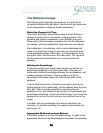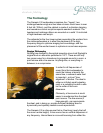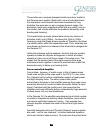
23
2323
23
absolute fidelity
The concept of our servo bass system is an easy one to
understand: It employs an accelerometer as a sensor to constantly
monitor the movement of the woofer cone and continuously
compares it to the input signal. This comparison circuit instantly
identifies any deviation from the input and applies a corrective
signal to compensate for any deviation, resulting in the virtual
elimination of the inherent distortion of the woofer.
As an example, when you have a high-impact, low-bass signal that
starts and stops suddenly (for example a tympani), the inertia of the
woofer cone makes it slow to start moving, and then after it has
started moving, the momentum of the cone makes it continue to
move after the signal has stopped. The sonic result is softness,
overhang, and bloat in the bass. This results in a perceived lack of
tautness and definition, and a blurring of dynamic impact.
With the servo system, the circuit senses that the woofer is not
moving as fast as it should, and it instantaneously applies much
more current to make it move faster. When the signal stops, it
predicts that the woofer will continue to move when it shouldn’t be
moving and applies a counter-signal to stop the woofer faster and
more effectively than an open loop woofer could possibly respond.
Thus, the servo-drive reduces distortion and improves transient
response by making the woofer appear to be massless. Typical
non-servo woofer systems have distortion levels that exceed 10%
at even moderate levels. The Genesis servo bass system reduces
this distortion to below one percent at almost any output level. The
system also drives the woofer to constant acceleration, which
makes the frequency response of the woofer anechoically flat to
the lowest frequencies.
The Woofer Tower
The transducer used in a servo system must be strong enough to
withstand the high current approach of the servo, and yet delicate
and light enough to react extremely quickly. The G2.2 features a
total of four front- and four rear-firing 8-inch woofers per channel –
a total of sixteen woofers in the system.
While the servo system is able to ensure that the driver works
linearly as a perfect piston, it is unable to correct for distortion
caused by cone wobble, bending, and break-up. Hence, the drivers
were designed to minimize these non-linear distortions.


















